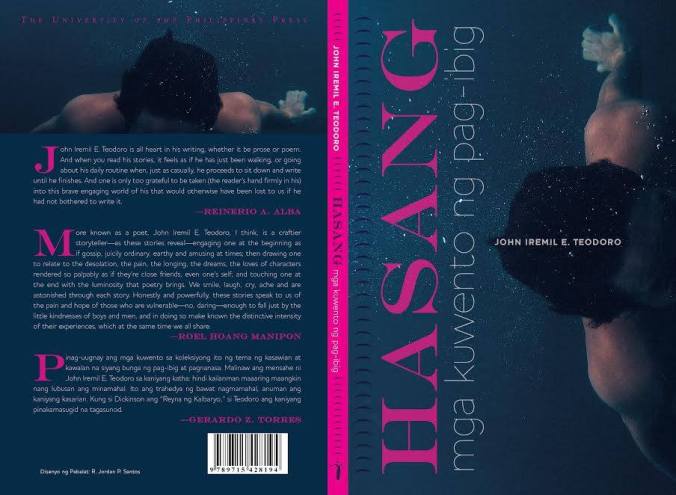(An edited version of this article appeared in the January 9, 2017 issue of The Daily Tribune’s Life section)
Having followed the author’s literary career for over a decade now, he insists that I may have already read many of the stories in his new book. Curiously, I flip through the first pages and realize that his story-telling still captivates me the same way it did many years back. His words are free-flowing like the waves that embrace this archipelago. The stories are both beautiful and haunting at the same time. Beautiful because they celebrate the undying human condition of love; haunting because they illustrate the often suppressed, unspoken truths in the lives of many gay men in the country today. What all main characters in each story have in common is the desperate longing for a life they most likely can never have. The rest is then left to the reader’s imagination.

Hasang: Mga Kuwento ng Pag-Ibig by John Iremil E. Teodoro is a nine-story collection that deals with both the emotional and social complexities of the love between two men. Depicting the daily lives of homosexual Filipino men through his colorful portrayals, the multi-award-winning writer from San Jose de Buenavista, Antique has masterfully crafted another milestone in his career publishing the first ever gay-themed short story collection using Visayan-laced Filipino under none other than the University of the Philippines Press.
Teodoro writes in a tone that is unjudgmental and unassuming, one that refrains from stirring propaganda or criticizing any institution: From a successful Manila-based medical representative haunted by a dream that leads him to a small fishing community in Guimaras to a former biology student mourning over the news of a batchmate’s sudden death, a college instructor reminiscing the memory of a departed pupil, an openly gay parlor shop owner participating in a municipal procession for his boyfriend’s involvement in an ugly crime, a half-German lad travelling to his late father’s abandoned island resort only to encounter a supernatural surprise, a literary professor confronting the ego-tripping of an ex-lover, a Ph.D. candidate diagnosed with HIV visiting his hometown to witness a religious ritual for his unfinished novel, a professor coming to terms over the unexpected suicide of a Chinoy lover and a call center agent coping with the worsening drug addiction of a former classmate. They are individuals of profound depth and struggle who naturally form part of the national macrocosm of Filipino life. As contemporary as they get, these stories are a compilation of short fiction accumulated by the author over the past two decades having previously appeared in various publications.
Each plot unfolds uniquely with a wide-ranging set of characters with settings ranging from the urban to rural, from civilization to the tropical wilderness, from abandoned places to densely populated spaces. The narratives in this book take readers back to the author’s roots in Western Visayas illustrating a scenic portrait of Ilonggo cultural life with events occurring in the tourist-trendy Boracay Island, the historic city of Iloilo, the mountainous terrains of Antique province and the sleepy island-province of Guimaras. The characters, on the other hand, emerge bravely in every story not seeming to be bothered by the conservative forces in society that surround them. They simply embrace the world’s unpredictability as it is. At times, they can be funny and romantic and in some instances, they appear to be in intense grief and distress. What seems perplexing about these stories is the obvious absence of antagonists other than the bitter circumstances brought about by fate. Readers should not be surprised if certain characters strongly resemble the writer himself and some of his personal acquaintances, which keep one guessing which characters and instances in these stories are based on true-to-life events and persons. To spill some beans, some minor characters that briefly appear are indeed real-life individuals!
Also observable in the collection is Teodoro’s beautiful execution of the national tongue with his distinct style of infusing Hiligaynon and Kinaray-a terms and expressions making every page authentic to the reader’s senses. His Filipino does not seem to be forced and reads out like a lyrical script enjoyable to any adult reader. His ease with the ever-evolving Filipino language is indeed a commendable artistic feat that should be emulated by young writers. He remains one of those few authors of national influence who can offer a unique alternative to the often Manila-centric dilemma that still prevails in the country’s literary scene today. It will certainly change the way academicians, language advocates and literary enthusiasts view our national language. As the Peruvian Nobel Literature Prize laureate Mario Vargas Llosa repeatedly emphasized during his recent visit to Manila, it is important for writers to produce good literature for society to savor as it offers them an alternative world and social order in parallel to the existing reality, which readers may, be it consciously or subconsciously, wish to aspire for.
With the rise of nationwide LGBT awareness campaigns in the past decades and the emergence of a more globally conscious millennial generation, perceptions towards gay men in the country’s cultural landscape have certainly changed a lot since Danton Remoto and J. Neil C. Garcia have co-published the first Ladlad anthology of gay fiction in the 1990s. Across all walks of life, the gay cause now occupies a prominent place in Philippine popular culture and continues to be in constant flux. With this new feat, Teodoro has once again made an invaluable contribution to modern Filipino gay writing reaffirming its status as a thriving genre within contemporary Philippine Literature. This is a book that will certainly leave even the most English-centric of readers and writers in awe. Overall, this groundbreaking collection is more than just a celebration of life and love. It is a blossoming of hope that will surely inspire many in the continuous struggle for genuine equality.




